Saccharomyces cerevisiae transcription elongation mutants are defective in PUR5 induction in response to nucleotide depletion
- PMID: 11003640
- PMCID: PMC86296
- DOI: 10.1128/MCB.20.20.7427-7437.2000
Saccharomyces cerevisiae transcription elongation mutants are defective in PUR5 induction in response to nucleotide depletion
Abstract
IMP dehydrogenase (IMPDH) is the rate-limiting enzyme in the de novo synthesis of guanine nucleotides. It is a target of therapeutically useful drugs and is implicated in the regulation of cell growth rate. In the yeast Saccharomyces cerevisiae, mutations in components of the RNA polymerase II (Pol II) transcription elongation machinery confer increased sensitivity to a drug that inhibits IMPDH, 6-azauracil (6AU), by a mechanism that is poorly understood. This phenotype is thought to reflect the need for an optimally functioning transcription machinery under conditions of lowered intracellular GTP levels. Here we show that in response to the application of IMPDH inhibitors such as 6AU, wild-type yeast strains induce transcription of PUR5, one of four genes encoding IMPDH-related enzymes. Yeast elongation mutants sensitive to 6AU, such as those with a disrupted gene encoding elongation factor SII or those containing amino acid substitutions in Pol II subunits, are defective in PUR5 induction. The inability to fully induce PUR5 correlates with mutations that effect transcription elongation since 6AU-sensitive strains deleted for genes not related to transcription elongation are competent to induce PUR5. DNA encompassing the PUR5 promoter and 5' untranslated region supports 6AU induction of a luciferase reporter gene in wild-type cells. Thus, yeast sense and respond to nucleotide depletion via a mechanism of transcriptional induction that restores nucleotides to levels required for normal growth. An optimally functioning elongation machinery is critical for this response.
Figures
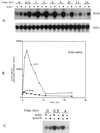
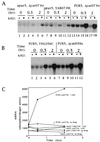
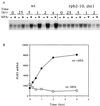
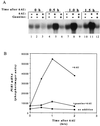



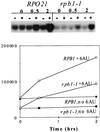

Similar articles
-
Large-scale screening of yeast mutants for sensitivity to the IMP dehydrogenase inhibitor 6-azauracil.Yeast. 2004 Feb;21(3):241-8. doi: 10.1002/yea.1068. Yeast. 2004. PMID: 14968429 Free PMC article.
-
Mutations in RNA polymerase II and elongation factor SII severely reduce mRNA levels in Saccharomyces cerevisiae.Mol Cell Biol. 1998 Oct;18(10):5771-9. doi: 10.1128/MCB.18.10.5771. Mol Cell Biol. 1998. PMID: 9742094 Free PMC article.
-
Regulation of an IMP dehydrogenase gene and its overexpression in drug-sensitive transcription elongation mutants of yeast.J Biol Chem. 2001 Aug 31;276(35):32905-16. doi: 10.1074/jbc.M105075200. Epub 2001 Jul 5. J Biol Chem. 2001. PMID: 11441018 Free PMC article.
-
Genetic interaction between transcription elongation factor TFIIS and RNA polymerase II.Mol Cell Biol. 1992 Sep;12(9):4142-52. doi: 10.1128/mcb.12.9.4142-4152.1992. Mol Cell Biol. 1992. PMID: 1508210 Free PMC article.
-
Single molecule transcription elongation.Methods. 2009 Aug;48(4):323-32. doi: 10.1016/j.ymeth.2009.04.021. Epub 2009 May 6. Methods. 2009. PMID: 19426807 Free PMC article. Review.
Cited by
-
RNA polymerase II elongation factors of Saccharomyces cerevisiae: a targeted proteomics approach.Mol Cell Biol. 2002 Oct;22(20):6979-92. doi: 10.1128/MCB.22.20.6979-6992.2002. Mol Cell Biol. 2002. PMID: 12242279 Free PMC article.
-
Separable functions of the fission yeast Spt5 carboxyl-terminal domain (CTD) in capping enzyme binding and transcription elongation overlap with those of the RNA polymerase II CTD.Mol Cell Biol. 2010 May;30(10):2353-64. doi: 10.1128/MCB.00116-10. Epub 2010 Mar 15. Mol Cell Biol. 2010. PMID: 20231361 Free PMC article.
-
Analysis of gene induction and arrest site transcription in yeast with mutations in the transcription elongation machinery.J Biol Chem. 2001 Apr 13;276(15):11531-8. doi: 10.1074/jbc.M011322200. Epub 2001 Jan 19. J Biol Chem. 2001. PMID: 11278887 Free PMC article.
-
Ctr9, Rtf1, and Leo1 are components of the Paf1/RNA polymerase II complex.Mol Cell Biol. 2002 Apr;22(7):1971-80. doi: 10.1128/MCB.22.7.1971-1980.2002. Mol Cell Biol. 2002. PMID: 11884586 Free PMC article.
-
Opposing roles for Set2 and yFACT in regulating TBP binding at promoters.EMBO J. 2006 Oct 4;25(19):4479-89. doi: 10.1038/sj.emboj.7601333. Epub 2006 Sep 14. EMBO J. 2006. PMID: 16977311 Free PMC article.
References
-
- Aparicio O M, Gottschling D E. Overcoming telomeric silencing: a trans-activator competes to establish gene expression in a cell cycle-dependent way. Genes Dev. 1994;8:1133–1146. - PubMed
-
- Ausubel F M, Brent R, Kingston R E, Moore D D, Seidman J G, Smith J A, Struhl K, editors. Current protocols in molecular biology. New York, N.Y: Greene Publishing Associates/Wiley-Interscience; 1988.
-
- Barton A, Bussey H, Storms R, Kaback D. Molecular cloning of chromosome I DNA from Saccharomyces cerevisiae: characterization of the 54 kb right terminal CDC14-FLO1-PHO11 region. Yeast. 1997;13:1251–1263. - PubMed
Publication types
MeSH terms
Substances
Grants and funding
LinkOut - more resources
Full Text Sources
Molecular Biology Databases
